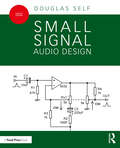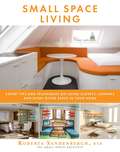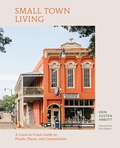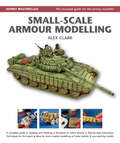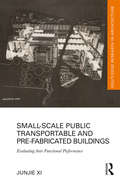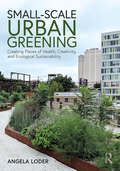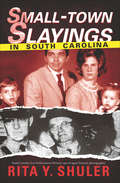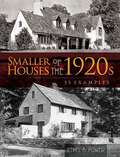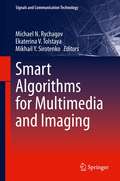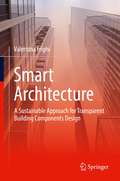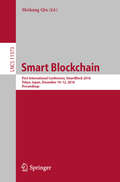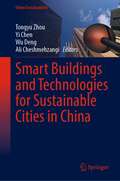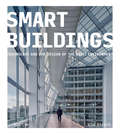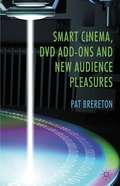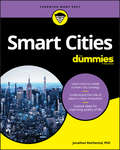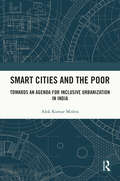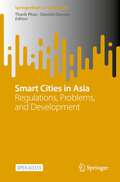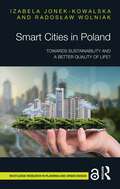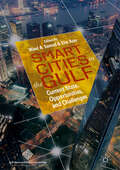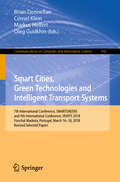- Table View
- List View
Small Signal Audio Design
by Douglas SelfSmall Signal Audio Design is a highly practical handbook providing an extensive repertoire of circuits that can be assembled to make almost any type of audio system. This fully revised fourth edition offers wholly new content on internally balanced audio design, electret microphones, emitter-follower stability, microphony in capacitors, and much, much more. This book continues the engaging prose style familiar to readers as you learn why mercury-filled cables are not a good idea, the pitfalls of plating gold on copper, and what quotes from Star Trek have to do with PCB design. Learn how to: make amplifiers with apparently impossibly low noise design discrete circuitry that can handle enormous signals with vanishingly low distortion transform the performance of low-cost opamps build active filters with very low noise and distortion while saving money on expensive capacitors make incredibly accurate volume controls make a huge variety of audio equalisers use load synthesis to make magnetic cartridge preamplifiers that have noise so low it is limited by basic physics sum, switch, clip, compress, and route audio signals build simple but ultra-low noise power supplies be confident that phase perception is not an issue. Including all the crucial theories, but with minimal mathematics, Small Signal Audio Design is the must-have companion for anyone studying, researching, or working in audio engineering and audio electronics.
Small Space Living: Expert Tips and Techniques on Using Closets, Corners, and Every Other Space in Your Home
by Roberta SandenberghComplete with demonstrative illustrations and photographs, Small Space Living offers more than one hundred space-saving ideas from Roberta Sandenbergh, a.k.a the Small Space Architect.Sandenbergh will introduce you to the idea of space opportunities—untapped areas in every home that can be expanded for storage and organizational purposes. A space opportunity might be as simple as using an empty space under a stairway or above a doorway or as complicated as dividing your entire apartment for rental income.Each chapter addresses a different kind of space opportunity area, including closets, corners, walls, windows, ceilings, and floors. In these areas, you will be inspired by Sandenbergh’s creative approaches to divided spaces, stacked spaces, empty spaces, mirrored spaces, and multipurpose furniture. Learn from the author’s stories of her own designs for “small-by-choice” homes—for herself and for her clients—in which she tried to make the best possible use of varied living spaces. Allow Sandenbergh to help you create more space-efficient and attractive areas in your home whether you live in a studio apartment, a tiny home, or a larger home that needs more of a cozy feel.
Small Town Living: A Coast-to-Coast Guide to People, Places, and Communities
by Erin Austen AbbottCelebrate the joys of small town life in this stunning, coast-to-coast photographic ode to country stores, main streets, and the inspiring creatives who have embraced life outside the city center. "An idyllic celebration of the rural life." —Publishers Weekly Big changes are taking place in how we live—and what we look for in the place we call home. From remote work options to the pull of wide open spaces and simpler lives, families, couples, and singles alike are looking away from major metropolitan areas and towards small towns. But where to go? How? When? There&’s a lot to consider when you&’re thinking about making the move to a small town—or just daydreaming about doing so. With the wisdom of an author who has made the move herself, Small Town Living answers these key questions in this sweeping, lushly photographed celebration of living small. Author and photographer Erin Austen Abbott has traversed the country to find creatives—from aquaculture preservationists to visual artists to entrepreneurs—who have opted for cozy towns over metropolitan bustle. In illuminating interviews and atmospheric photographs Austen Abbott showcases nearly two dozen couples and individuals who have embraced small town life, from the wilds of rural Maine, to the plains of Texas, villages of the Hudson Valley, and breathtaking seascapes of the Pacific Northwest. Woven throughout these regional chapters (East, Midwest, South, and West) are tips and sidebars to help readers begin their own small town journeys—from determining what's really important to you (like proximity to a university or access to hiking trails) to sensitively integrating into the community. A rich appendix showcases dozens of small towns grouped by themes like Small Museums, LGBTQIA+ Friendly, Film Festivals, as well as a list of small towns by state to inspire wanderlust.
Small, Broke, and Kind of Dirty: Affirmations for the Real World (Solon Series #3)
by Hana ShafiLet's get one thing straight: Small, Broke, and Kind of Dirty: Affirmations for the Real World is not a book of advice. You're not going to find a step-by-step guide to meditation here, or even reminders to drink lots of water and get enough sleep. Those things are all good for you, but that's not what Hana Shafi wants to talk about.Instead, Small, Broke, and Kind of Dirty—built around art from Shafi's popular online affirmation series—focuses on our common and never-ending journey of self-discovery. It explores the ways in which the world can all too often wear us down, and reminds us to remember our worth, even when it's hard to do so. Drawing on her experience as a millennial woman of colour, and writing with humour and a healthy dose of irreverence, Shafi delves into body politics and pop culture, racism and feminism, friendship, and allyship. Through it all, she remains positive without being saccharine, and hopeful without being naive.So no, this is not an advice book: it's a call to action, one that asks us to remember that we are valid as we are—flaws and all—and to not let the bastards grind us down.
Small, Broke, and Kind of Dirty: Affirmations for the Real World (Solon Series #3)
by Hana ShafiLet's get one thing straight: Small, Broke, and Kind of Dirty: Affirmations for the Real World is not a book of advice. You're not going to find a step-by-step guide to meditation here, or even reminders to drink lots of water and get enough sleep. Those things are all good for you, but that's not what Hana Shafi wants to talk about.Instead, Small, Broke, and Kind of Dirty—built around art from Shafi's popular online affirmation series—focuses on our common and never-ending journey of self-discovery. It explores the ways in which the world can all too often wear us down, and reminds us to remember our worth, even when it's hard to do so. Drawing on her experience as a millennial woman of colour, and writing with humour and a healthy dose of irreverence, Shafi delves into body politics and pop culture, racism and feminism, friendship, and allyship. Through it all, she remains positive without being saccharine, and hopeful without being naive.So no, this is not an advice book: it's a call to action, one that asks us to remember that we are valid as we are—flaws and all—and to not let the bastards grind us down.
Small-Scale Armour Modelling
by Alex ClarkSince the mid-1990s, small-scale armour modelling has seen a great resurgence in popularity. This is largely due to major injection-moulded kit manufacturers such as Revell of Germany and, a few years later, Dragon Models Ltd entering the market for 1/72-scale armour models. Alongside this, numerous aftermarket manufacturers have also turned their attention to this scale and many types of accessories that were previously associated only with larger scale models are now available and commonplace for those in 1/72 scale. The popularity of this scale is also borne out by regular new releases and the continuing appearance of new aftermarket manufacturers. Reference and reading materials pertinent to this scale have also kept pace with these developments. Virtually all of the major modelling magazines feature small scale modelling articles, news and kit reviews. For a number of years there has been a successful, glossy, small-scale only magazine called Minitracks. On the Internet, there are numerous websites dedicated to small-scale modelling. Many of the most popular modelling sites, such as Missing-Links, have successful small scale forums and discussion groups. This book will cover all of the major aspects of small-scale armour modelling and will give an insight into Mr. Clark's approach to construction, painting, finishing and presentation.From the Hardcover edition.
Small-Scale Public Transportable and Pre-Fabricated Buildings: Evaluating their Functional Performance (Routledge Research in Architecture)
by Junjie XiThis book investigates the design, operation and use of contemporary transportable buildings, and explores how functional performance can be assessed in small-scale examples for public use alongside their relationship to other design elements. The research focuses on three case studies, Chengdu Hualin Elementary School, Exxopolis and Kreod, that do not require a high-technology building environment or complex construction skills. Transportable buildings are defined as those that are transported in a number of parts for assembly on site. Contemporary transportable buildings respond to ecological issues, social impacts, technological innovation and economic demands. They can be used to measure a society’s development in environmental sustainability, innovation and economic growth through various forms. Small-scale transportable buildings fulfil many temporary habitation needs in diverse roles, such as non-emergency transitional housing, ephemeral exhibition buildings and seasonal entertainment facilities. Small-Scale Public Transportable and Pre-Fabricated Buildings will be a useful research text for academics and students in architecture, design and sustainable building performance.
Small-Scale Urban Greening: Creating Places of Health, Creativity, and Ecological Sustainability
by Angela LoderSmall-scale urban greening projects are changing the urban landscape, shifting our experience and understanding of greenspaces in our cities. This book argues that including power dynamics, symbolism, and aesthetics in our understanding of the human relationship to urban nature can help us create places that nurture ecological and human health and promote successful and equitable urban communities. Using an interdisciplinary approach to current research debates and new comparative case studies on community perceptions of these urban greening projects and policies, this book explores how small-scale urban greening projects can impact our sense of place, health, creativity, and concentration while also being part of a successful urban greening program. Arguing that wildness, emotion, and sense of place are key components of our human–nature relationship, this book will be of interest to designers, academics, and policy makers.
Small-Town Slayings in South Carolina (True Crime Ser.)
by Rita Y. ShulerA former forensic photographer and author of Murder in the Midlands chronicles horrific killings that struck at the heart of the Palmetto State. Ax assault, kidnapping, brutal murder: how could these things happen in a small town? Although regional crimes hardly ever make it to the national circuit, they will always remain with the families and communities of the victims and a part of the area&’s history. After working with the South Carolina Law Enforcement Division as special agent/forensic photographer for twenty-four years, Rita Shuler has a passion for remembering the victims. In Small-town Slayings, Shuler takes us back in time, showing differences and similarities of crime solving in the past and present and some surprising twists of court proceedings, verdicts, and sentences. From an unsolved case that has haunted her for thirty years to a cold case that was solved after fifteen years by advanced DNA technology, Shuler blends her own memories with extensive research, resulting in a fast-paced, factual, and fascinating look at crime in South Carolina. Includes photos!
Smaller Houses of the 1920s: 55 Examples
by Ethel B. PowerFrom a peak era in American domestic architecture comes this survey of homes from across the country. Its wealth of styles features both new American designs and traditional European-inspired buildings of wood, stucco, concrete, brick, and stone. The 130 captioned black-and-white illustrations and 55 floor plans offer external and internal views for a full perspective on the houses' architectural ingenuity and originality. <p><p> One of the most striking features of these homes is their extreme variety in terms of efficient design. The plans combine a limited number of units into a workable whole, without sacrifice of convenience or economy. Blending practicality and charm, these imaginative designs will inspire professional architects, amateur builders, and anyone interested in the ways American architects adapted Old World designs and added elements of native style to produce a new and vibrant home building idiom.
Smart Algorithms for Multimedia and Imaging (Signals and Communication Technology)
by Michael N. Rychagov Ekaterina V. Tolstaya Mikhail Y. SirotenkoThis book presents prospective, industrially proven methods and software solutions for storing, processing, and viewing multimedia content on digital cameras, camcorders, TV, and mobile devices. Most of the algorithms described here are implemented as systems on chip firmware or as software products and have low computational complexity and memory consumption. In the four parts of the book, which contains a total of 16 chapters, the authors address solutions for the conversion of images and videos by super-resolution, depth estimation and control and mono-to-stereo (2D to 3D) conversion; display applications by video editing; the real-time detection of sport episodes; and the generation and reproduction of natural effects. The practical principles of machine learning are illustrated using technologies such as image classification as a service, mobile user profiling, and automatic view planning with dictionary-based compressed sensing in magnetic resonance imaging. The implementation of these technologies in mobile devices is discussed in relation to algorithms using a depth camera based on a colour-coded aperture, the animated graphical abstract of an image, a motion photo, and approaches and methods for iris recognition on mobile platforms. The book reflects the authors’ practical experience in the development of algorithms for industrial R&D and the commercialization of technologies.Explains digital techniques for digital cameras, camcorders, TV, mobile devices;Offers essential algorithms for the processing pipeline in multimedia devices and accompanying software tools;Features advanced topics on data processing, addressing current technology challenges.
Smart Architecture – A Sustainable Approach for Transparent Building Components Design
by Valentina FrighiThis book explores the specific role that glazing technologies play within the world of smart architecture as important components of contemporary and future sustainable architectural and technological research. Smart Architecture begins with a definition of the concept of “smart” in architecture and examines how innovative technologies and materials have shaped buildings over the years. The author then provides a supporting database of contemporary smart architecture—mapping adopted strategies, recognizing common patterns, and evaluating current and future trends in the context of smart building envelopes, energy efficiency, and the development of high-potential innovative building components. The book proceeds with a focus on the specific role that glazing technologies play in this framework and provides a systematic methodology to quantify options for the effective integration of transparent building components within advanced and innovative building envelope systems.
Smart Blockchain: First International Conference, SmartBlock 2018, Tokyo, Japan, December 10–12, 2018, Proceedings (Lecture Notes in Computer Science #11373)
by Meikang QiuThis book constitutes the refereed proceedings of the First International Conference on Smart Blockchain, SmartBlock 2018, held in Tokyo, Japan, in December 2018. The 17 papers presented in this volume were carefully reviewed and selected from 102 submissions. They focus on a broad range of topics in the area of blockchain, from privacy-preserving solutions to designing advanced blockchain mechanism, from empirical studies to practical manuals.
Smart Buildings and Technologies for Sustainable Cities in China (Urban Sustainability)
by Ali Cheshmehzangi Wu Deng Yi Chen Tongyu ZhouThis book brings together the insights from professional associations who involved in developing relevant national standards in China, domestic and international scholars who are dedicated to research in related fields, and industry practitioners who have the most hands-on experience. Synthesizing their perspectives, this book discusses the advanced technologies that can meet the requirements for energy efficiency, building performance monitoring and management, and user-centric building services, which are considered the essential components for achieving sustainable and smart cities. Moreover, it provides reflections on the implementation of smart technologies and strategies in practice.
Smart Buildings: Technology and the Design of the Built Environment
by Ron BakkerHow is technology shaping our built environment and changing the practice of architecture? This book explores how buildings and spaces are designed, built, used, and better understood through technology. A practical guide to technical advances including Internet of Things (IoT), 3D printing, innovative materials and robotics, Smart Buildings also outlines the opportunities for architecture including improved communication, flexibility, wellbeing, productivity and data collection. Bringing together multidisciplinary contributions and case studies from across the globe, this book provides an inspiring practical guide on how technology can inspire new architectural ideas, improving quality, comfort, health and wellbeing in the built environment
Smart Cinema, DVD Add-Ons and New Audience Pleasures
by Pat BreretonExamining post-1990s Indie cinema alongside more mainstream films, Brereton explores the emergence of smart independent sensibility and how films break the classic linear narratives that have defined Hollywood and its alternative 'art' cinema. The work explores how bonus features on contemporary smart films speak to new generational audiences.
Smart Cities (The MIT Press Essential Knowledge Series)
by Germaine HalegouaKey concepts, definitions, examples, and historical contexts for understanding smart cities, along with discussions of both drawbacks and benefits of this approach to urban problems. Over the past ten years, urban planners, technology companies, and governments have promoted smart cities with a somewhat utopian vision of urban life made knowable and manageable through data collection and analysis. Emerging smart cities have become both crucibles and showrooms for the practical application of the Internet of Things, cloud computing, and the integration of big data into everyday life. Are smart cities optimized, sustainable, digitally networked solutions to urban problems? Or are they neoliberal, corporate-controlled, undemocratic non-places? This volume in the MIT Press Essential Knowledge series offers a concise introduction to smart cities, presenting key concepts, definitions, examples, and historical contexts, along with discussions of both the drawbacks and the benefits of this approach to urban life.After reviewing current terminology and justifications employed by technology designers, journalists, and researchers, the book describes three models for smart city development—smart-from-the-start cities, retrofitted cities, and social cities—and offers examples of each. It covers technologies and methods, including sensors, public wi-fi, big data, and smartphone apps, and discusses how developers conceive of interactions among the built environment, technological and urban infrastructures, citizens, and citizen engagement. Throughout, the author—who has studied smart cities around the world—argues that smart city developers should work more closely with local communities, recognizing their preexisting relationship to urban place and realizing the limits of technological fixes. Smartness is a means to an end: improving the quality of urban life.
Smart Cities For Dummies
by ReichentalBecome empowered to build and maintain smarter cities At its core, a Smart City is a collection of technological responses to the growing demands, challenges, and complexities of improving the quality of life for billions of people now living in urban centers across the world. The movement to create smarter cities is still in its infancy, but ambitious and creative projects in all types of cities—big and small—around the globe are beginning to make a big difference. New ideas, powered by technology, are positively changing how we move humans and products from one place to another; create and distribute energy; manage waste; combat the climate crisis; build more energy efficient buildings; and improve basic city services through digitalization and the smart use of data. Inside this book you’ll find out: What it really means to create smarter cities How our urban environments are being transformed Big ideas for improving the quality of life for communities Guidance on how to create a smart city strategy The essential role of data in building better cities The major new technologies ready to make a difference in every community Smart Cities will give you the knowledge to understand this important topic in depth and be ready to be an agent of change in your community.
Smart Cities and the Poor: Towards an Agenda for Inclusive Urbanization in India
by Alok Kumar MishraDeveloping countries worldwide have been embarking on ‘smart cities’ programmes using new technology solutions to improve public services. Faced with severe problems of digital divide, poverty, unemployment, inequality, and financial and social exclusion, these cities have to negotiate hard in order to reach their goals. This book examines urban governance, digital divide, poverty, unemployment, and financial and social exclusion and presents a theoretical perspective on inclusive cities, urbanization, migration, slums,and affordable housing. The book aims at formulating and implementing an agenda for inclusive, equitable, and sustainable urban development in tune with the UN-SDGs, the New Urban Agenda of Habitat III, and India’s new national urban missions. It probes into the scope of adopting inclusionary urban planning, zoning, and housing, financing inclusive city development, and poverty alleviation through municipal finance reforms using findings and lessons from detailed field studies of Indian cities. It also suggests an agenda for slum-free and poverty-free cities in an attempt to make these cities more people-focused, humane, and inclusionary. This book will be of interest to scholars and researchers of political science, policy studies, public administration, urban studies, urban planning and management, urban sociology, and geography, besides being of interest to policy researchers, community workers, grass roots researchers, policymakers, and sociologists.
Smart Cities and the Poor: Towards an Agenda for Inclusive Urbanization in India
by Alok MishraDeveloping countries worldwide have been embarking on ‘smart cities’ programmes using new technology solutions to improve public services. Faced with severe problems of digital divide, poverty, unemployment, inequality, and financial and social exclusion, these cities have to negotiate hard in order to reach their goals. This book examines urban governance, digital divide, poverty, unemployment, and financial and social exclusion and presents a theoretical perspective on inclusive cities, urbanization, migration, slums,and affordable housing.The book aims at formulating and implementing an agenda for inclusive, equitable, and sustainable urban development in tune with the UN-SDGs, the New Urban Agenda of Habitat III, and India’s new national urban missions. It probes into the scope of adopting inclusionary urban planning, zoning, and housing, financing inclusive city development, and poverty alleviation through municipal finance reforms using findings and lessons from detailed field studies of Indian cities. It also suggests an agenda for slum-free and poverty-free cities in an attempt to make these cities more people-focused, humane, and inclusionary.This book will be of interest to scholars and researchers of political science, policy studies, public administration, urban studies, urban planning and management, urban sociology, and geography, besides being of interest to policy researchers, community workers, grass roots researchers, policymakers, and sociologists.
Smart Cities in Asia: Regulations, Problems, and Development (SpringerBriefs in Geography)
by Thanh Phan Daniela DamianThis open access book examines different aspects of smart cities, including technology, urban development, sustainable development, finance, and privacy and data protection. It also covers a wide range of jurisdictions in Asia-Pacific: Hong Kong, Indonesia, Malaysia, Singapore, Thailand, and Vietnam. The book consists of two main parts. The first part includes general chapters that conceptualize smart cities and provide an overview of these cities’ problems such as privacy and data protection concern. The general chapters also discuss the role of public and private sectors in developing and governing smart cities. The second part encompasses country-specific chapters that examine the concepts addressed in the general chapters in practice by analyzing several specific smart city projects.This book provides researchers and practitioners with some knowledge of a smart city and its implication in the Asia context. The book is designed with some general chapters updating the literature on smart cities for readers who are interested in an overview of this concept. Audiences who are curious about how smart cities are perceived and implemented in some Asian jurisdictions are benefited from country-specific chapters. The book is also helpful to general audiences whose interests lay at the intersection of law, governance, and technology.
Smart Cities in Poland: Towards sustainability and a better quality of life?
by Izabela Jonek-Kowalska Radosław WolniakThis book considers and examines the concept of a Smart City in the context of improving the quality of life and sustainable development in Central and Eastern European cities. The Smart City concept has been gaining popularity in recent years, with supporters considering it to be an effective tool to improve the quality of life of the city’s residents. In turn, opponents argue that it is a source of imbalance and claim that it escalates the problems of social and economic exclusion. This book, therefore, assesses the quality of life and its unsustainability in Central and Eastern European cities within the context of the Smart City concept and from the perspective of key areas of sustainable development. Using case studies of selected cities in Central and Eastern Europe and representative surveysof Polish cities, this book illustrates the process of creating smart cities and their impact on improving the quality of life of citizens. Specifically, this book investigates the conditions that a Smart City has to meet to become sustainable, how the Smart City concept can support the improvement of the residents’ quality of life and how Central and Eastern European countries create smartcity solutions. Containing both theoretical and practical content, this book will be of relevance to researchers and students interested in smart cities and urban planning, as well as city authorities and city stakeholders who are planning to implement the Smart City concept.
Smart Cities in Poland: Towards sustainability and a better quality of life? (Routledge Research in Planning and Urban Design)
by Izabela Jonek-Kowalska Radosław WolniakThis book considers and examines the concept of a Smart City in the context of improving the quality of life and sustainable development in Central and Eastern European cities.The Smart City concept has been gaining popularity in recent years, with supporters considering it to be an effective tool to improve the quality of life of the city’s residents. In turn, opponents argue that it is a source of imbalance and claim that it escalates the problems of social and economic exclusion. This book, therefore, assesses the quality of life and its unsustainability in Central and Eastern European cities within the context of the Smart City concept and from the perspective of key areas of sustainable development. Using case studies of selected cities in Central and Eastern Europe and representative surveysof Polish cities, this book illustrates the process of creating smart cities and their impact on improving the quality of life of citizens. Specifically, this book investigates the conditions that a Smart City has to meet to become sustainable, how the Smart City concept can support the improvement of the residents’ quality of life and how Central and Eastern European countries create smartcity solutions.Containing both theoretical and practical content, this book will be of relevance to researchers and students interested in smart cities and urban planning, as well as city authorities and city stakeholders who are planning to implement the Smart City concept.Chapter 2 and 6 of this book are freely available as a downloadable Open Access PDF at http://www.taylorfrancis.com under a Creative Commons Attribution-Non Commercial-No Derivatives (CC-BY-NC-ND) 4.0 license.
Smart Cities in the Gulf: Current State, Opportunities, And Challenges
by Wael A. Samad Elie AzarIn this edited volume, academics and practitioners from various disciplines investigate the challenges, opportunities and frameworks in the implementation of Smart Cities in the Gulf.The volume presents insightful analyses and identifies key lessons learned through case studies covering four main themes including smart city frameworks and governance, resources and infrastructure, information and communication technologies, and the social perspective. In doing so, the book provides policy recommendations related to smart governance, as well as overall frameworks that cities can adopt in their process of transition, and knowledge that is integral to bridge the gap between various stakeholders in the Smart City milieu. This edited volume comprises extended versions of papers presented at a workshop held at the University of Cambridge, UK titled “Smart Cities in the GCC: Current State, Opportunities and Challenges.”
Smart Cities, Green Technologies and Intelligent Transport Systems: 7th International Conference, SMARTGREENS, and 4th International Conference, VEHITS 2018, Funchal-Madeira, Portugal, March 16-18, 2018, Revised Selected Papers (Communications in Computer and Information Science #992)
by Markus Helfert Brian Donnellan Cornel Klein Oleg GusikhinThis book constitutes the thoroughly refereed post-conference proceedings of the 7th International Conference on Smart Cities and Green ICT Systems, SMARTGREENS 2018, and the 4th International Conference on Vehicle Technology and Intelligent Transport Systems, VEHITS 2018, held in Funchal-Madeira, Portugal in March 2018.The 18 full papers presented during SMARTGREENS 2018 and VEHITS 2018 were carefully reviewed and selected from numerous submissions. The papers reflect topics such as smart cities and green ICT systems; vehicle technology and intelligent transport systems.
